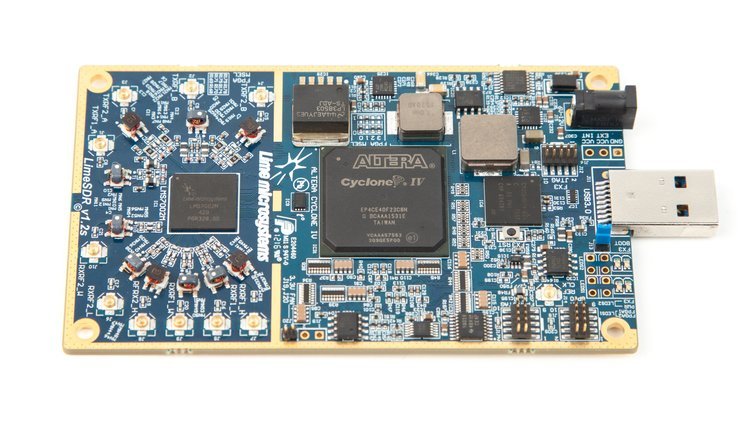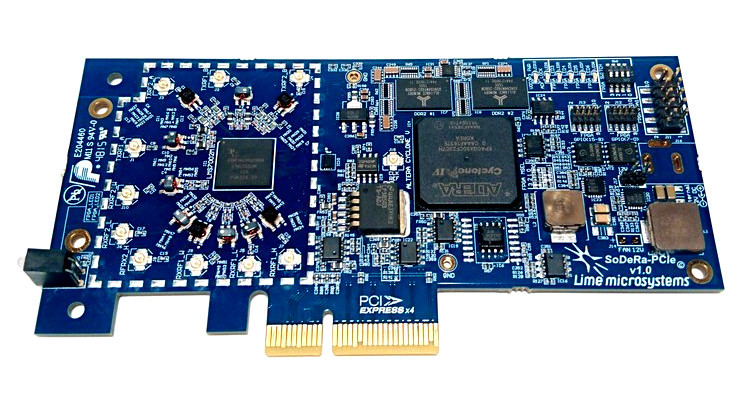LimeSDR SDR transceiver for $ 249

There is a fundraising for an open source SDR project called LimeSDR .
This project is attractive at an inexpensive cost of $ 249 for its technical specifications:
- frequency range: 100 kHz - 3.8 GHz
- frequency band: 61.44 MHz
- 12-bit ADC with Fd = 160 MHz and 12-bit DAC with Fd = 640 MHz
- 2 transmission channels and 2 reception channels (2x2 MIMO)
- FPGA: Altera Cyclone IV EP4CE40F23
- memory: 2 Gbps DDR2
- USB 3.0 interface for PC communication
It is interesting to note that the cost of only some components is $ 305.
Block diagram of the device:

The platform is based on Lime Microsystems LMS7002M radio chip, which contains LNA, receiver and transmitter mixers, receiver and transmitter filters, receiver gain control circuit, transmitter power control circuit, ADC and DAC.
')

For digital signal processing, the Altera Cyclone IV EP4CE40F23 FPGA is used, which contains 39,600 logic elements, 1134 KBytes of memory and 116 hardware multipliers. For high-speed data transfer, use a USB 3.0 controller Cypress CYUSB3014.
The table compares LimeSDR with other SDR platforms.
| Hackrf one | Ettus b200 | Ettus B210 | BladeRF | RTL-SDR | LimeSDR | |
| Frequency range | 1MHz-6GHz | 70MHz-6GHz | 70MHz-6GHz | 300MHz-3.8GHz | 22MHz-2.2GHz | 100kHz-3.8GHz |
| Frequency band | 20MHz | 61.44MHz | 61.44MHz | 40MHz | 3.2 MHz | 61.44MHz |
| Bit ADC / DAC | 8 bit | 12 bits | 12 bits | 12 bits | 8 bit | 12 bits |
| Sampling frequency | 20MHz | 61.44MHz | 61.44MHz | 40MHz | 3.2 MHz | 61.44MHz (Limited by USB 3.0 speed) |
| The number of channels to transmit | one | one | 2 | one | 0 | 2 |
| Number of receiving channels | one | one | 2 | one | one | 2 |
| Operation mode | half duplex | duplex | duplex | duplex | only reception | duplex |
| Interface | USB 2.0 | USB 3.0 | USB 3.0 | USB 3.0 | USB 2.0 | USB 3.0 |
| FPGA Capacity | 64 cells CPLD | 75k | 100k | 40k (115k) | - | 40k |
| Radio chip | MAX5864, MAX2837, RFFC5072 | AD9364 | AD9361 | LMS6002M | RTL2832U | LMS7002M |
| Source Code Availability | Complete | Only scheme and software | Only scheme and software | Only scheme and software | - | Complete |
| Frequency stability reference oscillator | ± 20ppm | ± 2ppm | ± 2ppm | ± 1ppm | ? | ± 1ppm initial, ± 4ppm stable |
| Radiated power | -10dBm + (15dBm @ 2.4GHz) | 10dBm + | 10dBm + | 6dBm | - | 0 to 10dBm (depending on frequency) |
| Price | $ 299 | 686 $ | $ 1119 | $ 420 ($ 650) | ~ 10 $ | $ 299 ($ 249 limited edition) |
Below are the possible uses of the board:
- Reception and transmission of signals of various wireless standards: GSM, UMTS, LTE, Wi-Fi, WiMax, ZigBee, Bluetooth, Tetra, LoRa
- DVB digital broadcast reception
- aircraft tracking via ADS-B
- vessel tracking via AIS
- listening to the negotiations of various dispatching services: air, ambulance, police, firefighters and rescuers
- listening to the radio
- Decoding navigation messages systems: GPS, Glonass, BeiDou, Galileo
- receiving signals from various satellites, for example, receiving meteorological images
- spectral analysis
- various types of radar (passive, active, XRD)
- study of wireless data transmission protocols
- direction finding of radio sources
- studying radio using Matlab and LabView
The platform is fully open , the project of the scheme of the device and the printed circuit board, the source code of the programs FPGA, microcontroller and client for the PC are available.
Plugins for GNU Radio, Pothos, SoapySDR and UHD are already available for PCs.
Since the project uses a BladeRF-like element base, it can easily transfer existing projects, such as: GSM base station, LTE base station , ADS-B decoder , various software panoramic receivers CW-SSB-WFM-FMRDS-AM , plugins to Matlab and LabView.
For $ 799, you can order a version with a PCI Express interface.

The planned delivery time for ready-made devices is November 30, 2016.
Source: https://habr.com/ru/post/395191/
All Articles